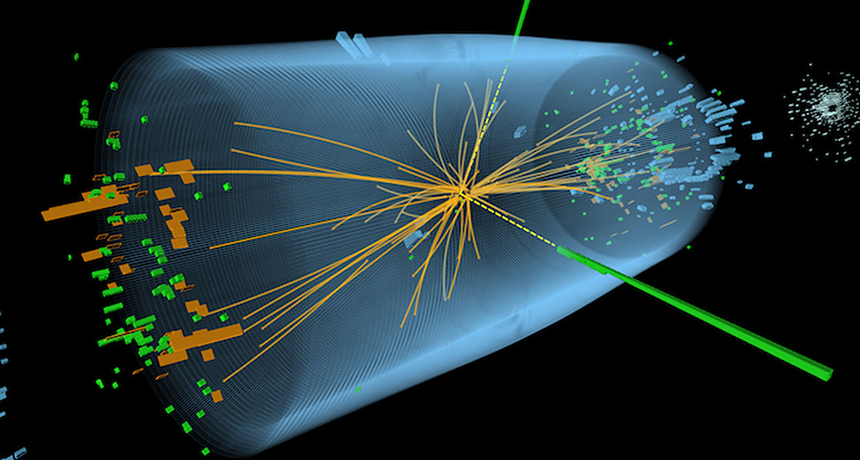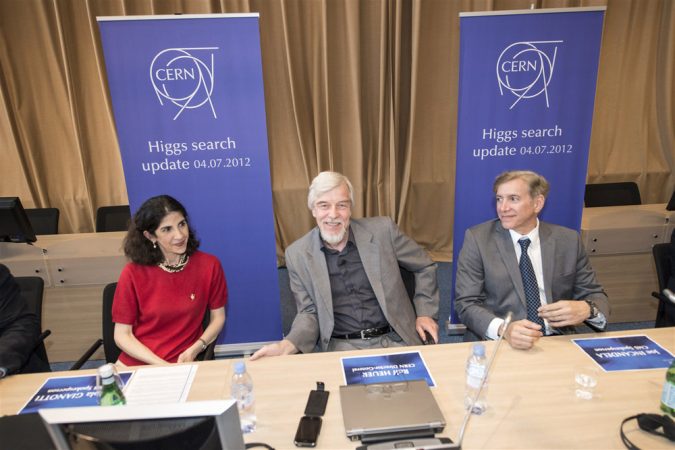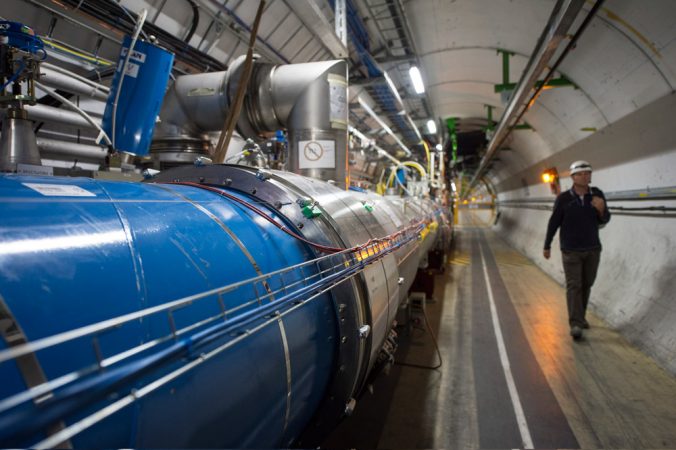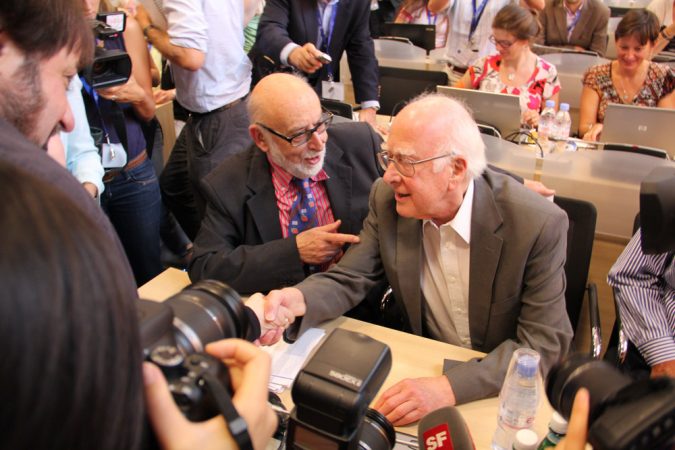Higgs — at last!
Physicists capture the long-sought Higgs particle, which explains why other particles have mass

The colorful sprays in this computer visualization are the tracks of particles created when two beams of protons collided. Scientists think a massive Higgs boson — a long-sought particle — might have been created during this collision at CERN, in Switzerland.
CERN
It took one of the biggest machines in the world to find one of the smallest particles.
Buried beneath the grassy countryside near Geneva, Switzerland, is a giant tunnel in the shape of a circle 8.6 kilometers (about 5 miles) across. There, scientists recently discovered a particle they had been hunting for a very long time: something called the Higgs boson (pronounced BOWZ-un).
The Higgs particle wasn’t just sitting there underground, waiting to be found. The scientists had to make it by slamming together other kinds of particles, head-on. That high-energy explosion made the Higgs boson, but only for a flash. In less than a second, the Higgs fell apart into other, lighter-weight particles.
But that moment was all scientists needed to say they had found the Higgs. They announced the discovery on the Fourth of July, just above the buried tunnel. The laboratory is called CERN (commonly referred to as the European Laboratory for Particle Physics).
Scientists were so excited about the Higgs that they lined up overnight just to get a seat in the room where the discovery would be announced. Some researchers popped open bottles of champagne when it was announced. Others cried.

So what was the big deal? And why was the particle’s discovery so hard to achieve?
To start with, look at your hand, or your computer, or the tree outside your window. All are made of matter — chemical substances made from molecules that have mass. Molecules are made of atoms, and atoms are made of even smaller bits known as fundamental particles.
Physicists have used math to describe all the particles in the universe, plus the forces that hold them together. This way of understanding particles and forces is called the “standard model.” Scientists have looked for and found every single particle that’s in the standard model — except the Higgs boson.
A boson is a particle that’s a little like a messenger. It carries some kind of force between other particles. In the case of the Higgs boson, it carries mass. That’s why the Higgs boson is so important. Without it, there would be no mass in the universe. There wouldn’t be any stars, planets, trees, computers or you.
At the beginning of time
Imagine traveling back 13.7 billion years ago. That’s shortly after the Big Bang — when the universe had just exploded into existence. Everything is very hot and very fast. Particles with no mass are zipping around at the speed of light. There is no matter anywhere.
But then the universe cooled enough so that something important could happen. Suddenly, a mysterious “field” spread throughout all of space, sort of like light illuminating a room when you flick on a switch. Somewhat like a magnetic field, this so-called Higgs field could influence any particles moving through it. That made movement a lot harder. Traveling through the field was like wading through a kiddie pool filled with water — it takes a lot longer than walking through an empty pool. Particles began to drag as they moved through this field. That slowing down gave the particles mass. And that mass meant that particles could get together for the very first time and form bits of matter. They could start to make things like stars.

Scientists called the source of this drag the Higgs field, after a physicist at the University of Edinburgh, Scotland, who helped come up with the idea of it in the mid-1960s. Physicists can’t look for the Higgs field directly, but they can look for a particle that has to exist if the Higgs field does too. That particle is the Higgs boson.
But this boson is really hard to see because it’s very rare and very unstable. That’s why scientists have to make it in underground smashups at CERN. They take protons (another kind of fundamental particle) and send them flying in opposite directions inside a mostly empty pipe in the tunnel. Engineers put supercooled magnets along the pipe, which create a strong magnetic field that pulls the protons along at top speed. By the end, those protons are traveling so fast that they loop around the tunnel thousands of times every second!
When the two streams of protons hit each other head-on, they release huge amounts of energy. Einstein’s famous equation, E=mc2, shows that energy (E) and mass (m) are essentially the same thing (in this equation, c stands for the speed of light). So when the protons collide, sometimes their energy gets converted into a very massive particle. That particle is the Higgs.
The creation of a Higgs particle doesn’t happen very often. Imagine every smashup at CERN is a grain of sand. You could do a trillion of those collisions, and your grains of sand would fill an Olympic-sized swimming pool. But out of those, the grains that represent a possible Higgs would fit on the tip of your finger.
Hunting the Higgs
Over the last two years, two different teams at CERN both found enough evidence for the Higgs particle to be sure they were making it in their smashups. Each team worked independently from the other one, to make sure its results were correct.
The Higgs turns out to weigh about as much as 133 protons. That makes it one of the most massive particles known.

Now that scientists have found the Higgs, their standard model is complete. But there still may be more surprises lurking. CERN physicists are smashing together proton beams through the end of this year, hoping to learn more about the Higgs. There’s even a chance it might be slightly different than the Higgs particle that scientists had expected.
If so, that means a lot more science is yet to come. Joe Incandela is a physicist at the University of California, Santa Barbara who worked on one of the two experiments at CERN. In some ways, he says, you can think of the Higgs discovery as similar to the time archaeologists found the tomb of Tutankhamun. There was the initial excitement when archaeologists opened the dusty door to King Tut’s tomb and found the Egyptian mummy. Later, when they had time to look around for a while, they found many more treasures they had originally missed.
Physicists may soon feel the same way about the Higgs. “We’re way out on the edge of understanding,” says Incandela. “This is exploration.”
Power words
accelerator A machine that makes particles go very fast so that scientists can use or study those particles for basic research.
Big Bang The time, 13.7 billion years ago, when the universe exploded into existence out of nothingness.
boson One of a group of particles that often carry forces between other particles.
hadron One of a group of particles that are made up of other, smaller particles held together by a particular kind of force. The protons and neutrons that make up you are hadrons.
field A region in space where certain physical effects operate, such as magnetism (created by a magnetic field), gravity (by a gravitational field) or mass (by a Higgs field).
mass A number that shows how much an object resists speeding up and slowing down — basically a measure of how much matter that object is made from.
particles (as in subatomic) The bits that interact with each other to make up the world around us. Light is made of particles. So is matter, the stuff that makes up you.
physicist A scientist who studies things like matter and energy.
proton A subatomic particle that is one of the basic pieces of matter. Protons belong to the family of particles known as hadrons (see above).
standard model The list of fundamental particles and the forces that hold them together, used by physicists to understand the world.
subatomic Anything smaller than an atom, which is the smallest bit of matter that has all the properties of whatever chemical element it is (like hydrogen, iron or calcium).
Word Find (click here to print puzzle)







